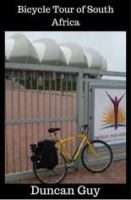
Photograph: South End as it once was
I headed inland on an uphill along Walmer Boulevard, then I returned freewheeling towards the ocean.
Something felt strange about the town planning. The harbour lay ahead of me, the city centre was to the left, the beachfront to the right but much of the route down Walmer Boulevard was open space covered with lawn.
Surely this would be land that should be in use by people who want to be near the city centre and near to the harbour?
The answer to my question lay in the South End Museum, housed in a building that was once a Mission for Seamen. The empty space along Walmer Boulevard had once been a place like Marabastad in Pretoria, where working class people of different races lived and traded alongside once another, until the arrival of apartheid.
However the removal of people to racially demarcated areas seemed to have been fiercer than in Marabastad. South End was bulldozed to the ground. The area was demarcated for whites who built upmarket properties on the graveyard of South End.
I’d not known about this chapter of Port Elizabeth’s history but it all sounded a very similar story to Cape Town’s District Six.
Fortunately, Ernest Moodaley, one of the trustees, was present when I called in at the museum and showed me around.
In a hall, a painting from a photograph showed life in South End: children playing together in a street with a ball, some barefoot, some with shoes, and the humble shops and businesses lining the street leading down to the docks where there were ships in port.
“It was based on a press photograph,” explained Ernest, himself a former resident of South End.
COMMENT: Had you heard of South End and its history?


